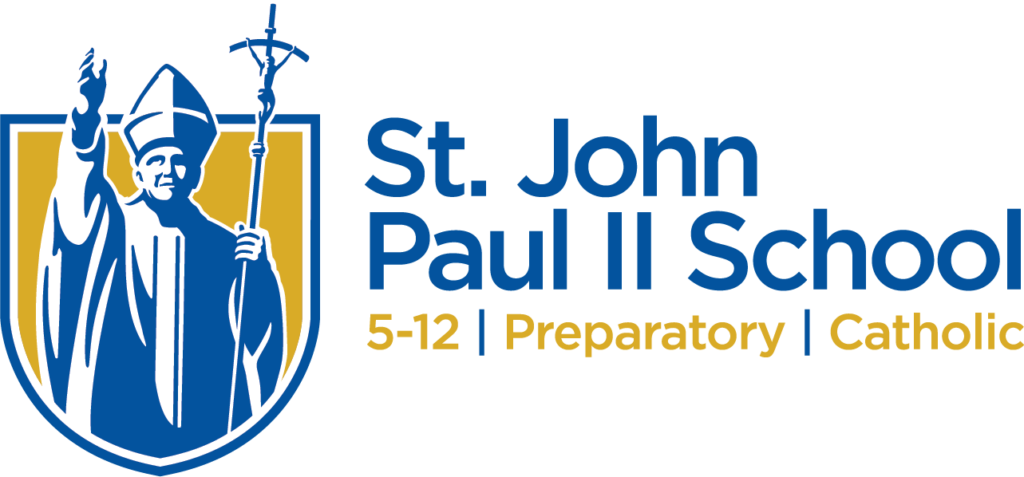Ways to Give
There are numerous opportunities for you to invest in facilities, programs, and services. In all cases, your gift becomes an investment in the lives of talented and promising young men and women. Review how you can make a difference today.
By including John Paul II School in your estate planning, you create a lasting legacy that supports Catholic education for future generations.
Recurring Gifts
B&G 12 is the recurring gift program at St. John Paul II School. A recurring gift is an ongoing, specific amount determined by a donor that is charged monthly to a donor’s credit card. The Blue & Gold Annual Fund gifts are used in the year they are received, so it is crucial to make a Blue & Gold Annual Fund gift every year. By committing to a recurring gift, you provide St. John Paul II School with steady, reliable funding for students and faculty.
How do I participate?
You can sign-up by visiting www.JPIIHyannis.org/GIVE. You agree to a contribution amount, which will be charged to your credit card accordingly.
Program Benefits
Spreading your support throughout the year is a convenient way to include your donations into your budget. Monthly giving is the most cost-efficient way to deliver your support.
Your gift will appear monthly on your credit card statement. We will send you a calendar year-end tax receipt each January to help in your tax preparations.
Sample Monthly Donations
$10 per month = $120 annually
$25 per month = $300 annually
$41.66 per month = $500 annually
$83.33 per month = $1,000 annually
$208.33 per month = $2,500 annually
$416.66 per month = $5,000 annually
Gifts of Assets
There are numerous opportunities for you to invest in facilities, programs, and services. In all cases, your gift becomes an investment in the lives of talented and promising young men and women. Review how you can make a difference today.
Gifts of real estate may include developed property, undeveloped property, or gifts subject to a prior life interest.
All other gifts of tangible personal property shall be examined in light of the following criteria: Does the property fulfill the mission of the school? Is the property marketable? Are there any undue restrictions on the use, display, or sale of the property? Are there any carrying costs for the property?
Marketable securities may be transferred to an account maintained by our school with a brokerage firm or delivered physically with the transferor’s signature or duly executed stock power attached. In some cases marketable securities may be restricted by applicable securities laws; in such instance, the final determination on the acceptance of the restricted securities shall be made by the Gift Acceptance Committee.
Planned Giving
You are encouraged to make a bequest to our school using your will and trust. Such bequests will not be recorded as gifts to our school until such time as the gift is irrevocable. When the gift is irrevocable but is not due until a future date, the present value of that gift may be recorded at the time the gift becomes irrevocable.
St. John Paul II School may offer charitable gift annuities. The minimum gift for funding is normally $10,000. The minimum age for life income beneficiaries of a gift annuity shall be 65. Where a deferred gift annuity is offered, the minimum age for life income beneficiaries shall be 45. No more than two life income beneficiaries will be permitted for any gift annuity. Generally, annuity payments may be made on a quarterly, semi-annual, or annual schedule.
St. John Paul II School must be named as both beneficiary and irrevocable owner of an insurance policy before your life insurance policy can be recorded as a gift. Your gift is valued at its interpolated terminal reserve value, or cash surrender value, upon receipt. If you contribute future premium payments, our school will include the entire amount of the additional premium payment as a gift in the year that it is made.
St. John Paul II School may accept designation as the remainder beneficiary of a charitable remainder trust with the approval of the Gift Acceptance Committee. We will not accept appointment as Trustee of a charitable remainder trust.
You are encouraged to name St. John Paul II School as a beneficiary of your retirement plans. Such designations will not be recorded as gifts to our school until such time as the gift is irrevocable. When the gift is irrevocable but is not due until a future date, the present value of that gift may be recorded at the time the gift becomes irrevocable.
St. John Paul II School may accept a designation as an income beneficiary of a charitable lead trust. St. John Paul II School will not accept an appointment as Trustee of a charitable lead trust.
IRA Charitable Rollover Gifts Permanently Extended
As you plan your minimum required distributions for this year, if you do not need the money the government is requiring you to take, consider using it for a charitable gift using the IRA Charitable Rollover.
In 2006 Congress made a change to the tax law that allows individuals age 70½+ to make charitable gifts directly from a traditional IRA account to charity without incurring federal income tax on the withdrawal. Many people have not heard about this option for making charitable gifts because it would expire every two years and need to be renewed by Congress.
H.R. 2029, the Protecting Americans from Tax Hikes Act of 2015, changed all that, making this provision a permanent, rather than temporary, part of the tax code (to the extent anything is permanent in the tax code). The IRA Charitable Rollover provides you with an excellent opportunity to make gifts during your lifetime from an asset that would be subject to multiple levels of taxation if it remained in your taxable estate.
To qualify
- You must be age 70½ or older at the time of gift.
- Transfers must be made directly from a traditional IRA account by your IRA administrator to our school.
- Funds that are withdrawn by you and then contributed DO NOT QUALIFY. Gifts from 401k, 403b, SEP and other plans do not qualify.
- Gifts must be outright. Distributions to donor-advised funds or life-income arrangements such as charitable remainder trusts and charitable gift annuities are not allowed.
Benefits — qualified charitable distributions
- Can total up to $100,000.
- Are not included in your gross income for federal income tax purposes on your IRS Form 1040 (no charitable deduction is available, however).
- Count towards your minimum required distribution for the year from your IRA.
Example
Suppose John has $500,000 in an IRA and he also wants to contribute $20,000 to our school. He can authorize the administrator of his IRA to transfer $20,000 to our school and $5,000 to himself. The $20,000 distributed to to the school will not be subject to federal tax and will be counted toward his annual minimum required distribution.
Frequently Asked Questions
H.R. 2029, the Protecting Americans from Tax Hikes Act of 2015 has permanently extended the IRA Charitable Rollover. Originally passed in 2006 as part of the Pension Protection Act, the IRA Charitable Rollover allows individuals age 70½ and older to make direct transfers totaling up to $100,000 per year to 501(c)(3) charities, without having to count the transfers as income for federal income tax purposes.
Who qualifies?
Individuals who are age 70½ or older at the time of the contribution (you have to wait until your actual 70½th birthday to make the transfer).
How much can I transfer?
$100,000 per year. The provision no longer has an expiration date.
From what accounts can I make transfers?
Transfers must come from your IRAs directly to our school. If you have retirement assets in a 401k, 403b etc., you must first roll those funds into an IRA, and then you can direct the IRA administrator to transfer the funds from the IRA directly to our school.
To what charities can I make gifts?
Tax exempt organizations that are classified as 501(c) (3) charities, including our school.
Can I use the IRA Charitable Rollover to fund life-income gifts (charitable gift annuities, charitable remainder trusts, or pooled income funds), donor advised funds or supporting organizations?
No, these are not eligible.
Can I use the IRA Charitable Rollover to support something specific like tuition assistance or the music department (or other)?
Yes, all IRA Rollover gifts can be used to support any important need.
How will our school count the gift?
We will give you full credit for the entire gift amount.
What are the tax implications to me?
- Federal — You do not recognize the transfer to our school as income, provided it goes directly from the IRA administrator to us. However, you are not entitled to an income tax charitable deduction for your gift.
- State — Each state has different laws, so you will need to consult with your own advisors. Some states have a state income tax and will include this transfer as income. Within those states, some will allow for a state income tax charitable deduction and others will not. Other states base their state income tax on the federal income or federal tax paid. Still other states have no income tax at all.
Does this transfer qualify as my minimum required distribution?
Once you reach age 70½, you are required to take minimum distributions from your retirement plans each year, according to a federal formula. IRA Charitable Rollovers count towards your minimum required distribution from the IRA for the year.
Can my spouse also make an IRA Charitable Rollover, even if we are married and file jointly?
Yes, every individual can use the IRA Charitable Rollover for up to $100,000 each year.
How do I know if an IRA Charitable Rollover is right for me?
You are at least age 70½, and:
- You do not need the additional income necessitated by your minimum required distribution, OR
- Your charitable gifts already equal 50% of your adjusted gross income, so you do not benefit from an income tax charitable deduction for additional gifts, OR
- You do not itemize deductions, OR
- You are subject to income phase-outs on your income tax deductions.
What is the procedure to execute an IRA Charitable Rollover?
Please speak with your plan provider to initiate a rollover. Please contact us when you direct the rollover so we can look for the check from your IRA administrator.
For more information, please email Advancement@JPIIHyannis.org.

